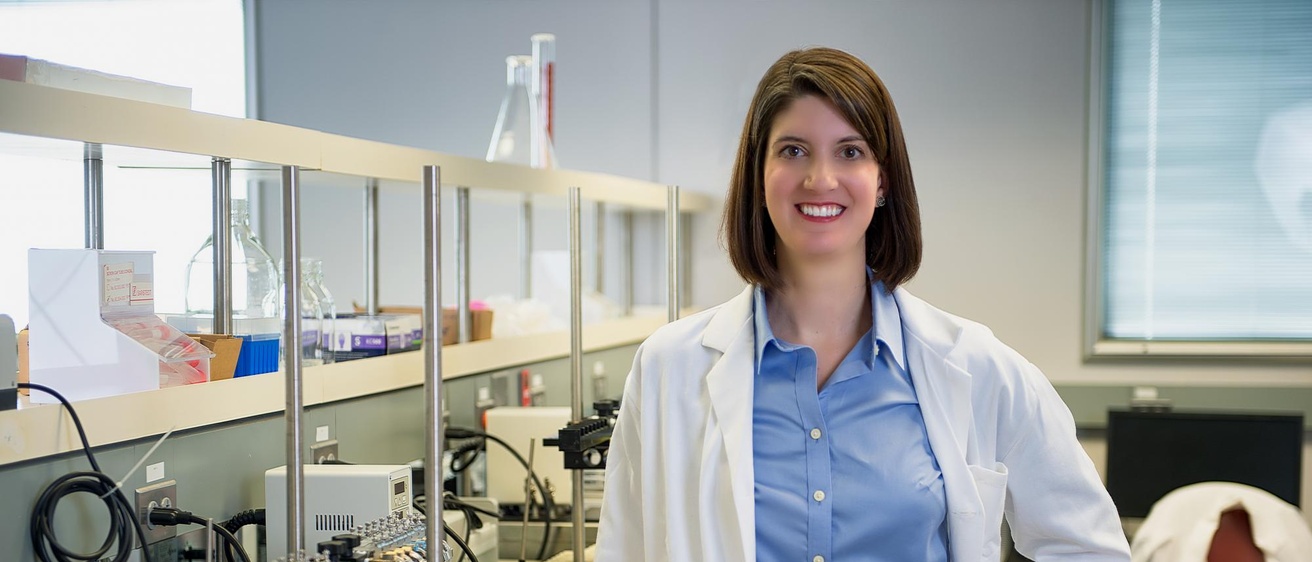Most of us don’t think too much about what our skin is made of. It’s just there doing its job, covering our bodies. But one University of Iowa College of Pharmacy faculty member sees bricks and mortar—and a constant challenge.
Nicole Brogden is an assistant professor in the UI College of Pharmacy’s Department of Pharmaceutical Sciences and Experimental Therapeutics (PSET). She primarily researches better ways to deliver medicine through older adults’ skin using microneedles (i.e., very small needles).
If you looked at it under a microscope, you would see that the thin outermost layer of a person’s skin is made up of “bricks” of cells embedded in a “mortar” of intercellular lipids (i.e., fats). That outer layer, the stratum corneum of the epidermis, is the body’s first layer of defense against bacteria and external injury. It also keeps out most medicines applied to the skin.
Using microneedles, Brogden is developing new and better ways to get therapeutic drugs into the bloodstream through that mortar. The main tool she uses is a penny-sized applicator with 50 microneedles. The “poke and patch” technique she uses involves applying the applicator to a patient’s arm—a painless procedure—removing it, then applying a medicated gel or patch over the 50 nearly imperceptible openings left behind. The administered drug crosses into the bloodstream to do its work until the skin heals itself. Using this approach, almost any medication can be delivered through the skin.
Since skin absorbs drugs slowly, transdermal delivery is ideal for the long-term delivery of medicines. This is especially true now that Brogden, in collaboration with Audra Stinchcomb, her graduate school mentor at the University of Kentucky (now of the University of Maryland), created a way to deliver a medication to a typical adult patient for an unprecedented seven days. The trick is to use a “helper” drug that prevents skin inflammation. Previously, three days was the proven maximum time frame.
Only a limited number of transdermal patches are currently on the market. They are available for birth control, the management of severe pain, and to help people overcome nicotine addiction. Other types of patches—including those used for alcohol and opioid addiction—are working their way to the market.
“These are often chronic therapies, so having a patient change a patch once every seven days is better than once every 48 hours,” says Brogden.
Since joining the College of Pharmacy—her alma mater—as a faculty member in 2012, Brogden’s main goal has been to make drug therapies easier for older adults.
Skin changes over a person’s lifetime, and Brogden plans to develop new patch-based therapies for people 65 and over by first studying how older skin functions and how this affects medication delivery.
Indeed, older adults face a number of unique challenges. Microneedles used with medicated patches can simplify drug treatment regimens and improve compliance.
“It is very hard to obtain venous access for IV drug delivery in geriatric patients, yet these patients also find it difficult to swallow pills and other common oral dosage forms,” Brogden says. “They tend to have a variety of different medications to manage at the same time and may struggle to remember to take them. With transdermal delivery, we could avoid many of these issues.”
Scientists have known about microneedles since the 1970s, but it wasn’t until the last decade or two that the engineering techniques were available to design them for commercial use.
“This is an interesting area to be in because it’s the convergence of three big fields: pharmaceutics, engineering, and biology,” Brogden says.
Since joining the college’s faculty, Brogden has forged the first-ever official collaboration between the college and the Carver College of Medicine’s Department of Dermatology.
Brogden—a Boone, Iowa, native—has also co-authored five manuscripts so far with her father, Kim Brogden, of the College of Dentistry.
